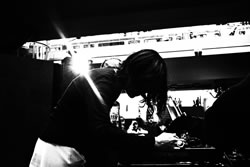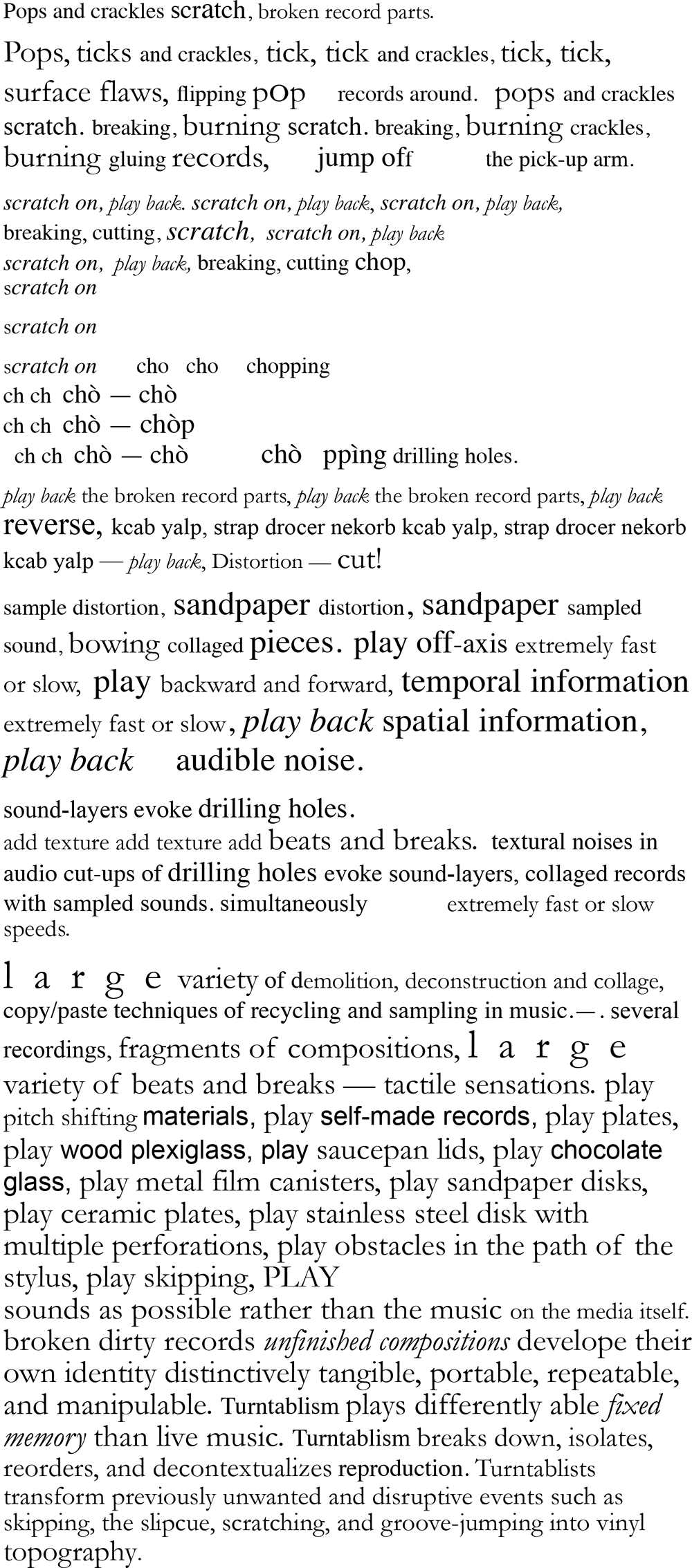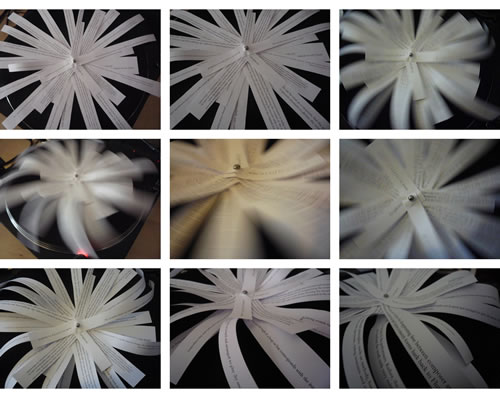Instant Cut

The text collage below is a remix of several articles published in this issue and in issue 14.3 on Turntablism. JD Zazie’s rearrangement of text material excerpts from existing articles, using cut-up methods and transformations typical to turntablism, mirrors the experimental practices that these editions explore and present. Just as a turntablist might select and arrange record samples, she tested sentences or phrases for their sonic qualities in order to compose “sound poetry.” JD Zazie uses the creative potential of the close relationship between audio and visual. When we read her collage, we don’t actually hear it as audio but can certainly imagine what it would sound like. Likewise, in a turntable performance, we can hear the different samples and references to music or noises and imagine their origins as a visual object.
In favour of the creative process of this piece we have not, as is usually done, indicated each and every source with an inline reference, which would have effectively destroyed the flow of the text. Please consult the bibliography below for a complete list of the sources used in this piece.
— Karin Weissenbrunner, Guest Editor
Turntablism Is Creation through Destruction
a Phonograph Record player — “in the hands of, in the hands of, in the hands of” a hip hop hip scratch artistic / avant-garde discourse — plays a record to another layer that is less strict and serious which allows reflective moments. Like an electronic washboard with a phonographic needle as a plectrum it can be used as a subversive argument.
a recording, transforming instrument, the record player, a recording, transforming instrument, the record player — as a playback device — a recording, transforming instrument, the record player becomes a musical instrument to create a recording, transforming instrument, the record player becomes record player, a documenting and creative device. a creative device, a recording, transforming record instrument, a recording, transforming instrument, the record transforming player, a creative device to create and compose artistic subversion.
explore and invent Record players bricolage. put systems or rules on another level of understanding explore and invent. transform a sound reproduction mechanism into a musical instrument, transform and use the record player and the records for non-intended purposes as subversive — invent multiple associative possibilities, new functions.
creation through destruction. phonograph and records bricolage subverts the intended functions of reproduction media. raw material reinterpreted for instrumental purposes. a wholly new form of music.
A Scratch on the Record

Dissolving the Function and the Form of the Player
As the material used is very basic, the output is stunningly raw. a motor-driven belt turns a platter at a constant rate while a needle, whose vibrations get amplified and translated, rides through a groove. “kakakakakakak” [it cuts a strong zigzag groove into the aluminium]. You remember the needle going? and has another sound. every material has a different [and unique] sound. another sound.
“swwichhhhuuuuwswwicchuuuw” [hissing/whistling sound]. another sound “shhhh” [darker, throaty sound] a different kind of “sh-v sh-v sh-v sh-v.” Often it ends in some kind of “screep, chhhhhrrrritttt, ffffrout” sound!
Replace the needle at the record’s beginning and, aside from any accumulated pops and clicks, you re-hear the sound. a very high sound like a saxophone.
So this could be interesting, to keep on researching the different materials and their sound. Because this struck me so much when I heard the recording the first time, all this universe of surface sounded “chhwchwchwchwchw” like an ocean.
I began constructing hand-made cartridges from discarded headphone speakers. This involved mounting the small speaker on the headshell and attaching a wire, a spring or other sharp object to the membrane of the speaker and wiring the speaker connection to the headshell leads (in mono). Attempts at getting higher fidelity resulted in much more fragile cartridges. Conversely, the more robust the cartridges were made, the less sensitive they became. After constructing the cartridges, I gathered together various objects to place on the turntables and
and played changing the needles for springs and played the needle and cartridge of the player scraped and tapped against various objects and played a coil of wire replacing the needle and played the needle in the cartridge on the tone arm replaced with several objects like feathers, wires, pipe-cleaners or matches and played contact microphones and pick up arms amplifying more noises and played tiny piezo elements to record the vibrations of long sections of fencing wire.
By preparing the needle in this manner, the loudspeakers transmit a unique noise instead of that of the actual audio on the record. The vibration picked up by the improvised stylus is in this way transduced — in reverse — from the speaker membrane to the electronic systems.
The performers rubbed the prepared cartridge on objects, changing the cartridges for contact microphones, constructing hand-made cartridges from discarded headphone speakers. they put objects such as feathers in a cartridge of a record player (instead of the tone needle), changed the amplification, used objects with attached contact microphones and created loops. sounds with record players and contact microphones among other objects. all types of objects were amplified and played live on stage. once the record is spinning very fast, it is getting very hard to keep the needle on it and it gets very hard to keep spinning it so fast. it often ends in some kind of “screep, chhhhhrrrritttt, ffffrout” sound!
every material has a different [and unique] sound. another sound. “swwichhhhuuuuwswwicchuuuw” [hissing/whistling sound]. another sound “shhhh” [darker, throaty sound] a different kind of “sh-v sh-v sh-v sh-v.” Often it ends in some kind of “screep, chhhhhrrrritttt, ffffrout” sound!
Advanced use of record players extend the function of the machine — rotating surfaces, triphonic turntable with three pick-up arms, Octogrammoticum, “no-record” record player-. Lot of plates “kch kch kch,” kill kill kill. sounds of the turntable itself without any records very breakable.
The deconstruction of the record player — ability of the player to create its own sound “has evolved from a meta-level to a first-level sound device.”
The deconstruction of the record player has become the primary source of electroacoustic instrumentation for me. I produce sounds acoustically in most instances by using the sound of the machine, proper or by producing sound through the player. You know, those old record players in the radio studios, they were sometimes only just the machine and the tone arm was also separate. You can pile up several layers of records and pick-up arms to a tower in order to play more than five records at the same time and you can use sticks on the turntable surface to stroke stretched rubber strings with every turn of the record player, in order to build up rhythmical patterns.
Earthy sounds, swelling and subsiding movements, gradual stops, standstills, returns and repetitions. looped audio messages from the loudspeaker’s horn which are brought into the present. sounds of the turntable itself without any records.
You remember? a Duchampian approach to the record player and records by recontextualizing the player’s purpose and also causing us to re-examine the information found on a record or data source. I find records fascinating and use them still within my œuvre, but it is the ability of the player to create its own sound that has inspired my practise.
I have placed a variety of contact microphones into the body of my institutional record player. The contact microphones invite sounds to be found through the record player’s own operation, such as the hum of motors, and by transforming the body of the machine into a sound-generating platform. The microphones allow for scraping, tapping and the placing of objects to reverberate on the body of the record player. The player itself can be used to generate sounds by the motor and the sounds made by just turning it on to be sampled, to be processed, or both.
When played with a quite strong distortion pedal effect, the whole turntable becomes very sensitive and every part of it makes its own specific noise. I also use a very sensitive tabletop microphone onto which I have stuck a stiff piece of cardboard: when pressed onto the side of the platter of the turntable, it creates a very high sound, like a saxophone… or like a train braking when stopping in the station……. or like a train braking when stopping in the station…. or like a train braking when stopping in the station…. or like a train braking when stopping in the station… or like a train braking when stopping in the station.
So how do you structure your live performance pieces — now that you have a vocabulary?
Are there formal ideas beforehand that you then execute, or how open do you leave the situation for decisions in the moment?
Destroying a priori coding of its purpose.

The larger your vocabulary is, the more particularly you can speak.
My recorded releases are made entirely to fulfill my own personal listening desires. || Noise as a tool for co-creation || Cacophony || Dragging a needle across a record. As a needle starts to change, the sound opportunities expand for a little bit, then they snap into a certain sound characteristic. || I’m interested in an approach that, rather than utilising the masterful control of a precise instrument in order to transmit the inner emotions and ideas of the composer, utilises imprecision in order to create an obstacle to such a process of transparency. In other words, I’m against expression. || Enhanced performance concepts, the disappearing line between composer and performer as well as improvised and open concert forms hark back to Fluxus. || Take a recorded Wallace speech, cut in stammering coughs sneezes hiccoughs snarls pain screams fear whimperings apoplectic sputterings slobbering drooling idiot noises sex and animal sound effects and play it back in the streets subway stations parks political rallies. || Modular approach where a number of individual samples are looped and arranged to play (by means of aleatory scripting techniques) in an infinitely changing mix. || Wondering where groove as pattern starts and ends, which length of a loop or bar corresponds with the inner / outer logic of a given piece in my ears. || Scratching the records; playing them using unconventional means or using various speeds at which the record was not intended to be listened to; reorganizing the content of the original self by relaying the record’s information through two tone arms; bowing the records with a violin bow; sanding the surface to help disguise the data and add textures not intended in the original recording. || Rather than organizing compositions on the basis of traditional principles such as melody, harmony or meter, Schaeffer and his associates relied on timbre, tone and spectrum, using textures and events to produce dynamics and narrative. || We work very much with a specific atmosphere and storyline in our music. We play more emotionally, in a sense. || The idea of handing over the compositional decisions to the machine (modified turntable, altered records, found objects). || Attempt to work in a non-musical manner has drawn attention to sound instead of arrangement, rhythm, narration or similar kinds of superstructures. || Accidents, chance, coincidencess. || Instituting a mechanical process that is somewhat beyond the artist’s control — to open up new possibilities where the sound is found rather than imagined. || Building an actual vocabulary of sound. That’s where chance jumped in. Objects deteriorate and as a result, new sound opportunities exist. || Demolition, deconstruction and collage are characteristic of Dadaism, as is a revolt against traditional culture and æsthetics. Dada artists denied their works of traditional compositional rules by using chance or absurdity in their works, and proclaimed that something new has to encounter resistance, otherwise it cannot be seen as new. || Creating unstable situations, which can be seen as a structure, but the goal is to encourage the present moment to dictate the sound pieces. || I work in an extension of the electroacoustic field, but one based on improvisation rather than composition. || Estheticizing of broken record parts || Effects are based on playing back the same disc simultaneously on the two turntables to keep beat of the song synchronized. || Manipulated the playback on the record player by, for example, playing sounds backwards, changing the speed or juxtaposing sounds using several record players. || Christian Marclay, who uses the record’s original content to be the fodder of his toolbox. He builds compositions through the use of the actual record’s information with distortions through turntable speed and movement, taking snippets of the sounds and playing them outside of the intended context. || Locked grooves, with the result that the record player repeats an endless loop of a short excerpt of the recording. || Very little expressive or virtuosic intervention on the part of the performers. Rather, the machines are let to perform the work with very minimal assistance. || Sculpting, carving or de-composing sound material instead of composing music led to a collection of 49 individual acoustic sculptures. || Using only portions of the record as a foundation for the creation of a new song. ||
Sources
eContact! 12.3 — Instrument—Interface (June 2010)
Hansen, Mike. “The Turntable is Dead, Long Live the Record Player.”
eContact! 14.3 — Turntablism (January 2013)
Andrews, Ian. “Lo-Fi Cartridge Construction and Function of the Constraint.”
Bellenger, Alexandre. “[Gallery] Alexandre Bellenger.”
DeLaurenti, Christopher. “The flap-o-phone, a Site-Specific Turntable.”
Engström, Andreas. “Worst Case Scenario: Interview with Vinyl Terror & Horror.”
Fuchs, Wolfgang. “The Tu(r)ning of the (W)o(r)ld.”
Hansen, Mike. “Talismania (Fetishizing the Fetish).”
Institut für Feinmotorik, . “Lab Report: Die 50 Skulpturen des Institut für Feinmotorik.”
Neumann, Daniel. “The Turntable Just Happened to be There — Chance and Turntablism(s): Interview with Maria Chavez.”
Oswald, John. “[Commentary] Mystery Tapes — My Desert Island Vinyl Collection.”
Roisz, Billy. “[Gallery] Billy Roisz.”
Sannicandro, Joseph. “[Report] Martin Tétreault’s Turntable Quartet in Akousma 9.”
Schick, Ignaz. “Plastik Fantastik: Interview with Sebastian Buczek.”
_____. “[Talk] 6 Questions to Turntablist Maria Chavez.”
Vinyl Terror & Horror. “[Gallery] Vinyl Terror & Horror.”
Weissenbrunner, Karin. “Editorial.”
eContact! 16.4 — Experimental Practices and Subversion in Sound / Pratiques sonores expérimentales et subversives (March 2015)
Maubert, Antony. “A Personal Approach to Subversion.”
Oswald, John. “Plunderphonics, or Audio Piracy as a Compositional Prerogative.”
Weissenbrunner, Karin. “Subversive Qualities in Experimental Practices.”
Social top